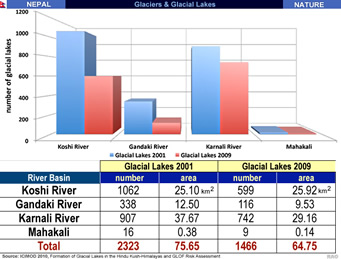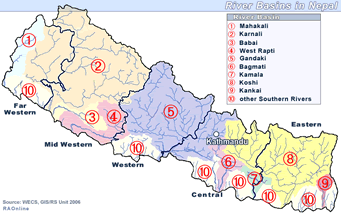| Nepal's
Glaciers - Climate Change |
 |
Nepal Himalayas Glaciers |
|
 |
Nepal Information |
|
|
 |
| Glacial Lakes Outburst Flood (GLOF) |
|
Himalayan Mountain Lakes at high risk of bursting
|
 |
Glacial Lakes in Nepal
Glacial lakes form when a glacier retreats leaving the debris mass at the end of the glacier - the end moraine - exposed. The moraine wall can act as a natural dam, trapping the meltwater from the glacier and leading to the formation of a lake. The moraine dams are composed of unconsolidated boulders, gravel, sand, and silt. As with landslide dams, they can eventually break catastrophically, leading to a glacial lake outburst flood or GLOF. GLOFs have the potential to cause extensive destruction in the downstream valley.
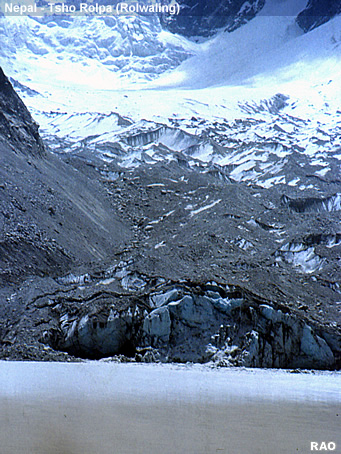 |
| GLOFs have been recorded in many different parts of the world, sometimes under other names. In 1941, an outburst flood destroyed the city of Huaraz in Peru killing 4,500 people. An outburst from a glacier-dammed lake in the Swiss Alps in 1968 triggered debris flow and caused heavy damage in the village of Saas Balen. On 4 August 1985, an outburst flood from Dig Tsho totally destroyed the nearly completed Namche Small Hydel Project and caused extensive damage farther downstream. Fourteen GLOF events have been recorded in Nepal, and another ten events where the outburst occurred in Tibet (China) but affected downstream communities in Nepal. On 11 July 1981, an outburst flood from the Zhangzangbo glacial lake in China caused extensive damage up to 50 km downstream into Nepal.
Altogether some 1,466 glacial lakes were identified in Nepal in a desk study using remote sensing data carried out in 2009; six of these were considered to be potentially dangerous. |
|
The outburst of such lakes depends upon the physical characteristic of the dam, the size and depth of the lake, and its surroundings.
As glacial lakes are increasing and expanding rapidly, the issues of GLOF risk assessment, early warning systems, and mitigation measures to reduce the impact have becoming ever more important.
At the same time it is important to realise that glacial lakes may offer considerable benefits to local community. They can provide a natural storage facility for water as water supplies becoming increasingly scarce, they are a focus for tourist activities, and they often have a high cultural significance. Thus they need to be looked after and managed in a controlled way that reduces any threat while helping the potential benefits to be realised.
Formation and growth of glacial lakes needs to be monitored on a routine basis as the situation is changing yearly. In order to assess the potential GLOF risk in Nepal in particular, and the Hindu Kush-Himalayan region in general, ICIMOD is implementing a project on 'Hazard Assessment and Mitigation Study of Potential GLOF Lakes in Nepal' to develop recommendations for adaptation to and mitigation of GLOF hazards from potentially dangerous glacial lakes in Nepal, and to assist Nepal in the development of an overall strategy on how to address risk from GLOFs in the future.
| Sources:
ICIMOD 2010
|
 |
top
Himalayan
Mountain Lakes at high risk of bursting their banks with devastating consequences
for people and property.
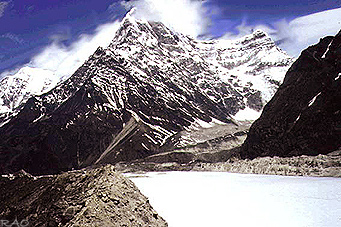 |
| Tsho
Rolpa, Rolwaling Valley (1996) |
Nearly
50 lakes, high in the Himalayas, could burst their banks sending millions
of gallons of deadly floodwaters swirling down valleys, putting at risk
tens of thousands of lives scientists are warning.
The
lakes are rapidly filling with icy water as rising temperatures in the
region accelerate the melting of glaciers and snowfields that feed them.
In
Nepal, for example, data from 49 monitoring stations reveals a clear increase
in temperature since the mid-1970s with highest temperatures found at higher
altitudes. |
|
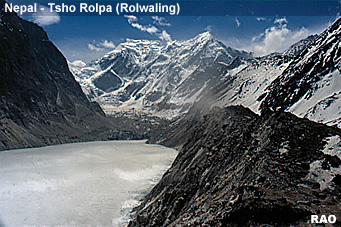 |
| Tsho
Rolpa, Rolwaling Valley (1996) |
|
On
average, air temperatures here are one degree C higher than in the 1970s
rising by 0.06 degrees C per year.
It is not just people who are at risk
but many millions of dollars worth of property, tourism facilities, trekking
trails, roads, bridges and hydro-electric plants which are the economic
life-blood of many countries in the region.
|
|
The
researchers have found that, as a result of the melting of a nearby glacier,
the the Tsho Rolpa Lake has grown six-fold, from an area of 0.23 square
kilometres in the late 1950s to one of 1.4 square kilometres in late 90ties.
The Tsho Rolpa Lake that feeds the Rolwaling and Tama Koshi valleys in
the Dolakha District of Nepal.

|
| Tama
Koshi valley near Dolakha |
top
| more information |
 |

|
|
Tsho
Rolpa, Rolwaling Valley
|
|



